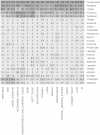Prioritization of anticancer drugs against a cancer using genomic features of cancer cells: A step towards personalized medicine
- PMID: 27030518
- PMCID: PMC4814902
- DOI: 10.1038/srep23857
Prioritization of anticancer drugs against a cancer using genomic features of cancer cells: A step towards personalized medicine
Abstract
In this study, we investigated drug profile of 24 anticancer drugs tested against a large number of cell lines in order to understand the relation between drug resistance and altered genomic features of a cancer cell line. We detected frequent mutations, high expression and high copy number variations of certain genes in both drug resistant cell lines and sensitive cell lines. It was observed that a few drugs, like Panobinostat, are effective against almost all types of cell lines, whereas certain drugs are effective against only a limited type of cell lines. Tissue-specific preference of drugs was also seen where a drug is more effective against cell lines belonging to a specific tissue. Genomic features based models have been developed for each anticancer drug and achieved average correlation between predicted and actual growth inhibition of cell lines in the range of 0.43 to 0.78. We hope, our study will throw light in the field of personalized medicine, particularly in designing patient-specific anticancer drugs. In order to serve the scientific community, a webserver, CancerDP, has been developed for predicting priority/potency of an anticancer drug against a cancer cell line using its genomic features (http://crdd.osdd.net/raghava/cancerdp/).
Figures
References
-
- Meyerson M., Gabriel S. & Getz G. Advances in understanding cancer genomes through second-generation sequencing. Nat Rev Genet 11, 685–696, doi: nrg2841 (2010). - PubMed
-
- Kalia M. Personalized oncology: recent advances and future challenges. Metabolism 62 Suppl 1, S11–14, doi: S0026-0495(12)00320-4 (2013). - PubMed
Publication types
MeSH terms
Substances
LinkOut - more resources
Full Text Sources
Other Literature Sources


